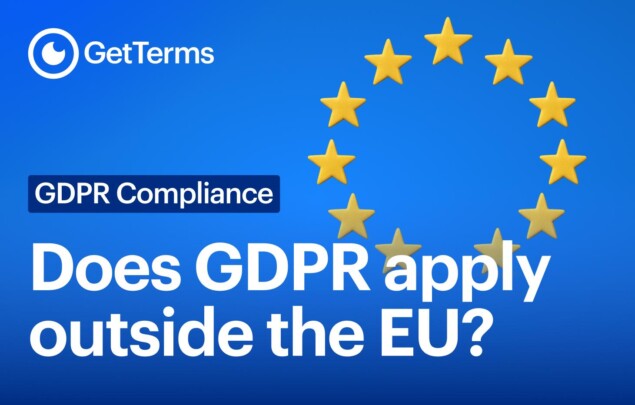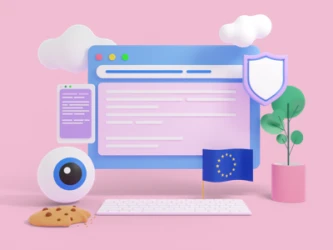Does the GDPR apply to businesses outside the EU?
Find out whether the GDPR applies to your business, even if you're not in the EU.

Create a GDPR-ready Privacy Policy, Terms & Cookie Banner in under 5 minutes.

A2P 10DLC refers to a system in which businesses use a 10-digit long code (10DLC) to send Application-to-Person (A2P) messages. Unlike traditional Person-to-Person (P2P) messaging, A2P is primarily one-way, where businesses send messages without expecting a reply. This system was developed to meet the growing needs of businesses for a secure, efficient, and scalable method to send large volumes of text messages.
The 10DLC system allows businesses to use a local phone number to send promotional messages, updates, notifications, and other business-related communications. This creates a more personal and trustworthy connection with customers compared to toll-free or short codes. Additionally, A2P 10DLC supports two-way messaging and voice calls, adding versatility to your communication strategy.
Generate your own Privacy Policy in under 5 minutes
Get StartedBusinesses today rely heavily on communication to engage with customers, provide services, and promote their offerings. As texting remains a powerful medium, organizations need effective tools to navigate SMS compliance. A2P 10DLC (Application-to-Person 10-digit Long Code) is one such solution, providing businesses with a compliant and reliable means of reaching their audience.
There are three main types of numbers businesses can use for text messaging:
Businesses have several options for sending A2P messages, including shortcodes, toll-free numbers, and 10DLC. Here’s a quick comparison:
| NUMBER TYPE | PROS | CONS |
| Short Code | Easy to remember, high-volume | Expensive (~$1,000+ monthly), one-way |
| Toll-Free | Free for customers, well-known | Less personal, higher chance of being ignored |
| 10DLC | Local, cost-effective, two-way messaging | Requires TCR registration, slower throughput than shortcodes |
In recent years, spam and fraudulent messages have become a significant concern for consumers. According to mobile carriers, there has been an overwhelming increase in unsolicited text messages, including phishing scams and spam campaigns. As a result, many consumers began to distrust even legitimate SMS communications. In response, the Federal Communications Commission (FCC) and mobile carriers implemented stricter regulations for business messaging.
A2P 10DLC provides a framework for businesses to communicate with customers in a compliant, trustworthy, and secure manner. By complying with A2P 10DLC regulations, businesses not only build trust with their audience but also benefit from improved message delivery rates, reduced risk of filtering or blocking, and protection from fines or penalties.
As SMS marketing surged in popularity, so did the misuse of texting for spam and phishing attacks. Consumers became increasingly skeptical of text messages, leading to the creation of A2P 10DLC. The system was designed by major North American mobile carriers (Verizon, AT&T, T-Mobile) in collaboration with regulators like the FCC (Federal Communications Commission) to improve the reliability and security of business messaging.
The Campaign Registry (TCR), a third-party organization, was established to manage and track A2P 10DLC registrations. Businesses must register their brand and messaging campaigns with TCR to gain approval and send messages via 10DLC. This process helps carriers vet legitimate businesses while filtering out unauthorized or spam messages.
A2P stands for Application-to-Person messaging, where a software application sends a message to a mobile user. Examples of A2P messaging include:
These messages are typically automated and transactional, meaning that they are designed to deliver useful, time-sensitive information rather than foster a conversation. A2P messaging is different from P2P (Person-to-Person) messaging, which is more conversational and usually involves two-way interaction.
A2P 10DLC offers several benefits, making it a game-changer for businesses looking to improve their messaging strategies:
The registration process for A2P 10DLC is straightforward but crucial for businesses looking to send SMS messages at scale. Here are the basic steps:
To send A2P messages using a 10DLC number, businesses must comply with several key requirements:
After successful registration, TCR assigns your campaign a trust score based on your compliance with messaging regulations. Carriers use this score to determine message throughput and delivery priority. Higher trust scores mean faster and more reliable message delivery.
Non-compliance with A2P 10DLC regulations can lead to serious consequences, including:
Once registered, businesses must adhere to ongoing compliance requirements. Carriers continuously monitor messaging traffic for signs of spam or non-compliance. It is crucial to follow best practices, such as including opt-out instructions in messages and avoiding sending unsolicited texts. Non-compliance may result in fines, message filtering, or even blocking of your messages.
Failing to comply with A2P 10DLC requirements can seriously affect your business. Mobile carriers began enforcing A2P 10DLC compliance on August 31, 2023. Businesses that fail to register or follow compliance standards may face the following:
A2P 10DLC is not just another compliance hurdle — it’s an opportunity to elevate your communication strategies. By adopting A2P 10DLC, your business can:
Ignoring A2P 10DLC can hinder your communication efforts, leading to missed opportunities and financial penalties. By embracing this system, businesses can unlock a more secure, reliable, and cost-efficient way to connect with customers.
A2P 10DLC compliance is essential for any business looking to leverage SMS for customer engagement and marketing. By understanding the registration process, adhering to compliance standards, and utilizing A2P 10DLC’s benefits, your business can forge stronger customer connections while avoiding costly fines and penalties. With the right approach, A2P 10DLC can be an invaluable tool to boost your business communication efforts.
Stay compliant, register for A2P 10DLC, and elevate your messaging strategy to meet today’s business needs.
Generate your own Privacy Policy in under 5 minutes
Get Started